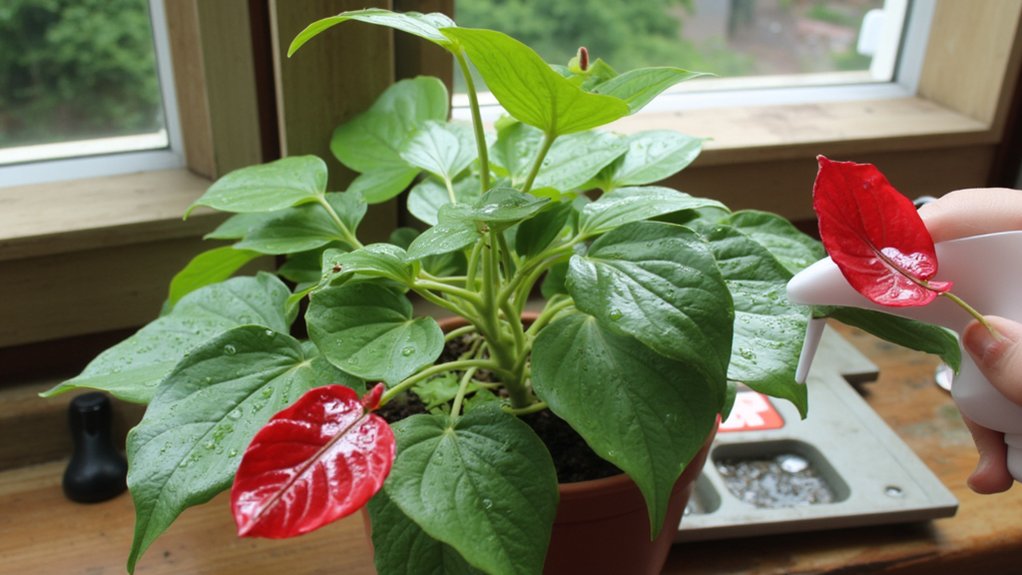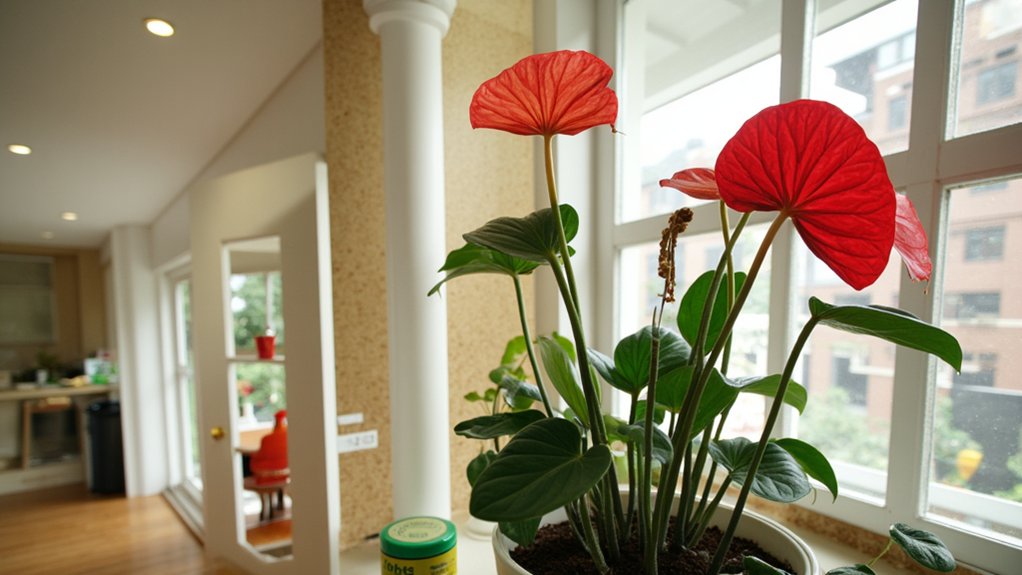If you’ve recently brought home an Anthurium plant, you’ll want to master the essentials of indoor care to keep those distinctive heart-shaped leaves and vibrant blooms thriving. These tropical beauties aren’t particularly demanding, but they do have specific needs when it comes to light, water, and humidity. Understanding the basics of Anthurium care will help you transform any indoor space into the perfect tropical oasis, and there’s quite a bit more to know about maintaining these striking plants.
Contents
Choosing the Perfect Location and Lighting

Whether you’re a beginner or experienced plant parent, selecting the right spot for your anthurium is essential for its success. Place your plant in bright, indirect light, keeping it at least 5-6 feet away from south or west-facing windows to prevent leaf burn. Direct sunlight will damage the leaves and flowers.
Your anthurium will thrive in temperatures between 65-80°F, away from cold drafts and heating vents. Choose a spot with good air circulation, but avoid placing it directly in front of fans or air conditioners. A humidity level of 60-80% is ideal, so consider grouping it with other tropical plants.
Soil Requirements and Potting Tips
The right soil mix can make all the difference for your anthurium’s root health and growth. Use a well-draining potting mix combining orchid bark, peat moss, and perlite in equal parts. For best results, add a handful of charcoal bits to prevent soil compaction.
Choose a pot that’s 1-2 inches larger than your plant’s root ball, ensuring it has drainage holes. When repotting, gently remove the anthurium, loosen any tangled roots, and position it at the same depth as before. Press the fresh soil mix around the roots firmly, but don’t compact it too much.
Watering and Humidity Needs

Since anthuriums are tropical plants, they’ll need consistent moisture without becoming waterlogged. Water your plant when the top inch of soil feels dry to the touch, typically every 5-7 days. Empty any standing water from the saucer after 30 minutes to prevent root rot.
These plants thrive in humidity levels between 65-80%. To increase moisture around your anthurium, mist the leaves daily with room temperature water, or place the pot on a humidity tray filled with pebbles and water. In dry environments, you’ll want to run a humidifier nearby to maintain ideal growing conditions.
Temperature and Climate Control
Maintaining ideal temperatures for your anthurium is essential for healthy growth and vibrant blooms. Keep your plant in temperatures between 70-85°F (21-29°C) during the day and no lower than 60°F (16°C) at night. You’ll want to avoid placing your anthurium near drafty windows or air conditioning vents.
These tropical beauties thrive in stable conditions, so try to minimize temperature fluctuations. If you’re growing anthuriums in a cooler climate, you might need to use a humidity tray or small space heater during winter months. Remember, they’ll show signs of stress, like yellowing leaves, if temperatures drop below their comfort zone.
Fertilizing Your Anthurium Plant

Proper fertilization plays an essential role in helping your anthurium produce vibrant flowers and maintain healthy foliage. Use a balanced, water-soluble fertilizer with an NPK ratio of 3-1-2 or 5-1-1, diluted to one-quarter strength during the growing season.
Feed your anthurium every six to eight weeks from spring through summer, but reduce fertilizing to once every three months during fall and winter. Don’t overfeed – it’s better to under-fertilize than risk burning the roots. If you notice brown leaf tips or wilting, you’re likely applying too much fertilizer.
When feeding, apply the solution directly to the soil, avoiding the leaves and flowers.
Pruning and Maintenance Techniques
Regular pruning of your anthurium keeps your plant healthy and attractive, building on the strong foundation created by proper feeding. Simply remove any yellow or brown leaves at their base using clean, sharp scissors. Don’t forget to trim spent blooms once they fade.
Check your plant monthly for dead or dying foliage, and prune away any stems that appear leggy or bare. When cutting, always make your cuts at a 45-degree angle, about 1/4 inch above a leaf node. This encourages new growth and prevents stem rot.
Wipe your anthurium’s leaves monthly with a damp cloth to remove dust and maintain their glossy appearance. This also helps you spot potential pest problems early.
Common Problems and Solutions
While anthuriums are generally hardy plants, they can face several common issues that’ll affect their health and appearance. Yellow leaves often indicate overwatering or poor drainage, while brown leaf tips suggest low humidity or excess fertilizer. If you notice these symptoms, adjust your care routine accordingly.
Spider mites and mealybugs can infest your anthurium, appearing as tiny specks or cotton-like clusters. Combat these pests by wiping leaves with neem oil solution or insecticidal soap every 7-10 days until they’re gone. Root rot, caused by soggy soil, requires immediate action – remove affected roots and repot in fresh, well-draining medium.
